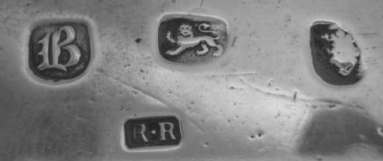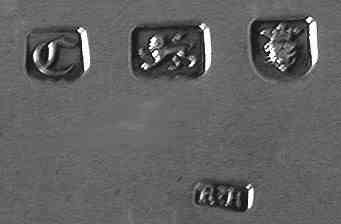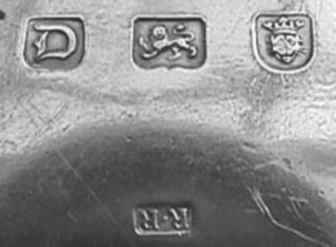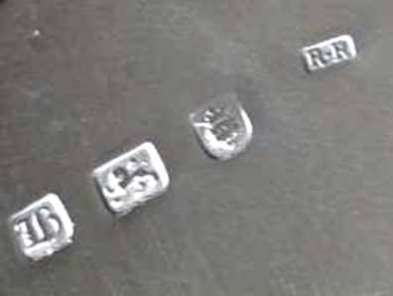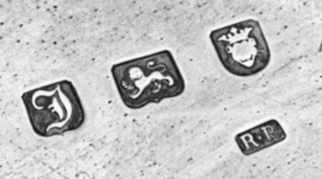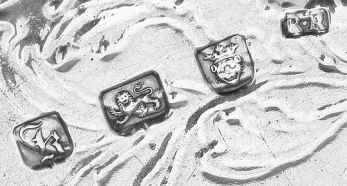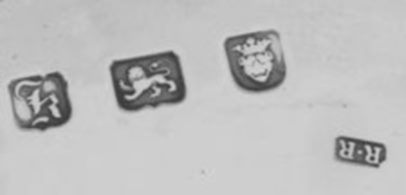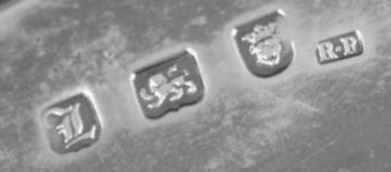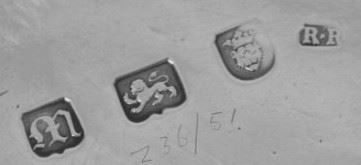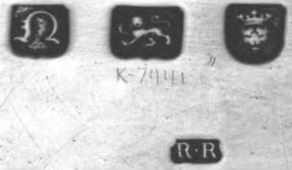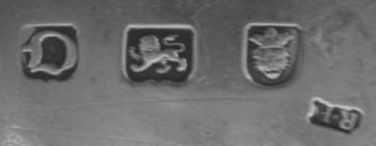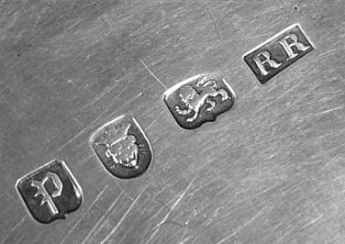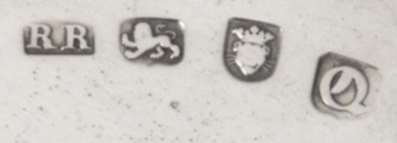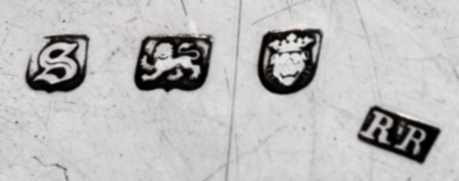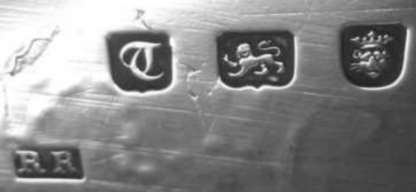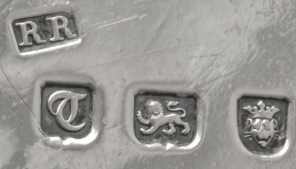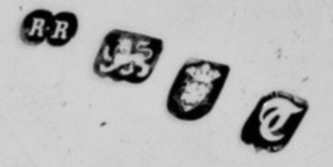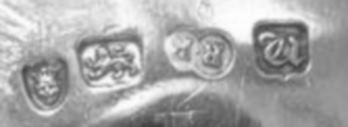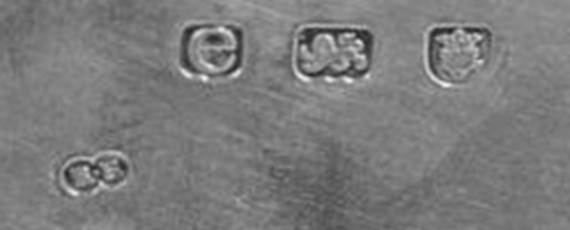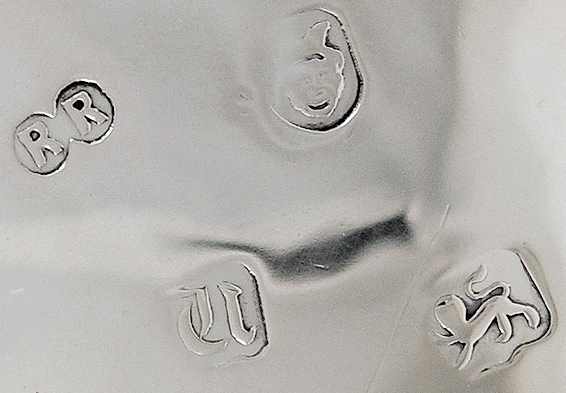
ASSOCIATION OF SMALL COLLECTORS OF ANTIQUE SILVER
ASCAS
| article # 172 |
|
|
|
|
(click on photos to enlarge image)A DEBATE ON THE ATTRIBUTION OF A MAKER MARK
|
 |
 |
Figure 1 – "RR" marks
registered at the Goldsmith’s Hall, according to
Grimwade
(see REFERENCE 1).
|
Referring to marks struck on salvers, a possible confusion
in the attribution can occur only with marks n. 2420 and 2422,
for the period between 1754 and 1775. At the latter date Richard
Rugg registered another marks (n. 2421) with a bilobed punch.
The other two similar marks (n. 2423 and 2424) refer to
smallworker
(see NOTE 2) and it would be very hard for them to
produce salvers, a particular branch among the category of
largeworker
(see NOTE 3) for specialist in cast works ((see
NOTE 4).
But is the question really closed?
Time ago I came across a salver hallmarked for London 1771 and
bearing the maker’s marks RR unpelleted. Who was the maker of
this salver? Neither Richard Rugg nor Robert Rew registered a
similar mark, or at least, according to Grimwade, there is no
record for this at the Goldsmiths' Hall.
The only silversmith to which a similar mark could be attributed
is Richard Redrick. His working activity overlaps those of Rugg
and Rew, but, as already said, he was a smallworker and then
should be excluded.
So, I started a more accurate research, including bibliographic
references written before the Grimwade work.
Wilfred Joseph Cripps in his "Old English Plate: ecclesiastical,
decorative, and domestic: its makers and marks "(see
REFERENCE 4), first published in 1878, reported the
marks showed in Figure 2.
 |
Figure 2 - Richard Rugg and Robert Rew marks reported by Cripps (see REFERENCE 4) on the base of the observation of real hallmarks struck on silver plate |
Cripps attributed a big RR unpelleted mark similar to that
impressed on the cited salver to Robert Rew, stating that the
R•R (pellet between) mark that he attributed to Richard Rugg is
of smaller dimension. Cripps has only worked on the base of
hallmarks struck on real examples of plate, so it is not clear
why he has come to this conclusion. No trace of both the larger
R•R pellet between Robert Rew mark and the R•R Richard Rugg mark
in a bilobed punch in the work of Cripps.
William Chaffer in his work "Gilda Aurifabrorum"
(see REFERENCE 5), dating 1899, reports the marks
showed in Figure 3, taken from the Register of Large Plate
Workers from 1739 to 1769 and in the Register of Small Workers
from 1758 to 1773 and Large Workers from 1774 to 1805, held at
the Goldsmiths’ Hall. Chaffer was the first person to whom was
permitted the consultation of the registers kept at the
Goldsmiths’ Hall and he reproduced all the marks as a facsimile
(see NOTE 5).
 |
Figure 3 – Richard Rugg and Robert Rew marks reproduced by Chaffer (see REFERENCE 5) on the base of the records found in the Register of Large Plate Workers from 30th May 1739 to 30th September 1769 and in the Register of Small Workers from 1758 to 1773 and Large Workers from 1774 to 1805, kept at the Goldsmith's Hall |
The marks are matching with those independently reproduced (photostatically)
by Grimwade, but the attribution is inverted, the larger one
being ascribed to Richard Rugg. Furthermore Chaffer also
reported the new RR Rugg mark in a bilobed punch but it is
reproduced without pellet. No trace in the registers of the RR
unpelleted mark, found by Cripps on a salver dating 1759.
A few years later, Montague Howard, in his "Old London silver –
its history, its makers and its marks", dating 1903
(see REFERENCE 6), reported a list of maker marks,
referring to Chaffer work "Gilda Aurifabrorum"
(see REFERENCE 5) and the elaboration given by Cripps
(see REFERENCE 4) (Figure 4).
 |
Figure 4 – Richard Rugg and Robert Rew marks reported by Howard (see REFERENCE 4) and derived by the works of Chaffer and Cripps |
The work is clearly a merge of the Cripps and Chaffer
researches but, again, it is not explained why Howard has judged
the work of Cripps to be more representative than that of
Chaffer for the two similar RR marks in a rectangular punch, and
has referred to the work of Chaffer only for the RR mark in a
bilobed punch, which, like in the Chaffer work, is reproduced
without pellet.
Charles J. Jackson
(see REFERENCE 7) in his "English Goldsmiths and
their marks - A history of the goldsmiths and plate workers of
England, Scotland and Ireland", first published in 1921, reports
the record of the registration of both Richard Rugg and Robert
Rew in 1754 and an example of the their marks as shown in Figure
5. Jackson specifies in another section of his work that the
reported marks have been found on salvers, apart the RR mark in
a bilobed punch which was observed on a fish slice. No marks
similar to that found on the cited salver (RR unpelleted) are
shown by him in the period of activity of the two silversmiths.
 |
 |
Figure 5 – Richard Rugg and Robert Rew marks reported by Charles J. Jackson (see REFERENCE 7) |
Jackson (like Cripps) has mainly worked on the base of real
hallmarks struck on wrought plate and he came across two
different salvers crafted in the same period (1760-1761 and
1761-1762 respectively), both struck with the R•R pellet between
mark in a rectangular punch. The two marks had different size,
and Jackson has ascribed the bigger one to Robert Rew. Again the
source of this attribution it is not clear.
The RR mark in a bilobed punch found by Jackson on a fish slice
and attributed to Rugg, is, like in Cripps and Montague works,
reproduced unpelleted. Although it is quite unusual that Rugg
has produced flatware, the date letter on this fish slice was
for 1775, indicating that it was marked between May 1775 and May
1776
(see NOTE 10), after the registration of this mark by
Richard Rugg in March 1775.
The only clear thing is that the historical sources are
contradictory. Difficult to say where the truth lies, but it is
likely that the most faithful situation is that given by
Grimwade (Figure 1), who should have taken into account all the
past published data. So, my research continued by collecting
examples of salvers of the second half of the XVIII century
struck with the maker’s mark RR. I found 65 examples of salvers
dating between 1754 and 1783 bearing these marks. Figure 6
reports all the found examples ranked by date letter. We can
draw the following consideration
(see NOTE 6):
• between 1754 and 1769, all the found maker’s marks (R•R) are
pellet between and of the same dimension (if compared with the
other marks);
• between 1770 and 1774, all the found maker’s marks (RR) are of
bigger dimension than that found before and unpelleted;
• since 1774 I only found examples bearing the new Richard Rugg
mark (R•R pellet between in a bilobed punch);
• no example of the RR unpelleted mark in a bilobed punch was
found in my survey
(see NOTE 7);
• no example of the bigger R•R pellet between mark was found in
my survey
(see NOTE 8).
Referring to the period 1754-1769, it seems that during my
research I came across only marks that, on the base of their
dimension, should be attributed to Richard Rugg, as they
apparently match that reported by Grimwade for this maker. This
seems to be in contradiction with the common belief that both
Rugg and Rew have been prolific salver makers working in the
same period (since 1754). Furthermore I found the bigger RR
unpelleted mark only on examples dating between 1770 and 1774,
while Cripps
(see REFERENCE 4) documented this mark since 1759.
Considering the record reported by Jackson (Figure 5) and an
error in the work of Cripps, concerning the record of the bigger
RR unpelleted mark (Figure 2) attributed to Rew (it would be
pellet between), a possible explanation can be that Robert Rew
produced a very few number of salver to allow that some examples
could be included in my survey. In conclusion Rew was not a
prolific salver maker as he is generally considered.
The only alternative would be that Robert Rew and Richard Rugg
adopted, at least after 1759, very similar marks, not only the
R•R pellet between mark, but also the RR unpelleted mark. It is
therefore highly unlikely that both silversmiths simultaneously
ceased the use of a similar mark to adopt, again, another -
different - similar mark.
After a very interesting exchange of opinion with Phil Osbourn,
the webmaster of the site www.silvermakersmarks.co.uk, I came at
the following conclusion:
• If we consider Grimwade as the most accurate source of
information, the marks found in my survey on salver dating
between 1754 and 1769, match that of Rugg's (n. 2420) and it is
not to be excluded that all the pre 1770 examples reported in
Figure 5 have been made by Rugg. If this is correct there is the
evidence that Rew produced only a very few number of salver to
appear in my survey.
• About the larger RR mark, it may not really be unregistered as
it would have been in the missing largeworkers' register for the
period 1758 to 1773
(see NOTE 9). It seems too coincidental that the
small R•R mark disappears from use, immediately followed by the
appearance of the larger RR unpelleted mark for them not to have
been those of the same silversmith.
• The fact I found salvers with the same date letter T for
1774/75 bearing either the RR unpelleted or the R•R bilobed
marks, could be not a contradiction because the date letter
usually changed in May each year
(see NOTE 10). The changeover by
Rugg from a large unpelleted RR to a bilobed R•R can be,
chronologically: • larger unpelleted RR mark from May-June 1774
to March 1775; • bilobed R•R mark from its registration in March
1775 to May 1775.
So, was Rew really a prolific salver maker or is this just a
symptom of the documented historical confusion between the two
silversmiths?
Apart the found evidences some questions are still open:
• there is no evidence that the bigger unpelleted RR mark was
effectively registered and, if so, either by Richard Rugg or
Robert Rew, being the register missing;
• one can argue that the hypothesis of the mark reported in the
missing register 1758-1773 can also be consistent with the RR
unpelleted mark reported by Cripps
(see REFERENCE 4) on a salver dating 1759 and, if so,
the attribution of this mark to Robert Rew would be more likely;
• it is a matter of fact that I did not found any example of the
bigger R•R pellet between mark in my research and the only
record available for it is that reported by Jackson (Figure 5),
and in principle we cannot exclude that the error was done by
Jackson and not by Cripps in the documentation of the bigger RR
mark, and that this mark was really unpelleted.
Another question that can arise is: does the bigger R•R pellet
between mark really exist? Phil, reports in his website a mark
R•R found on a sauce boat dating 1761 that can match with the
Robert Rew registered mark n. 2422
(see REFERENCE 8). But can this mark unequivocally be
attributed to Robert Rew? Grimwade
(see REFERENCE 3) reports that Richard Redrick used
similar marks (R•R pellet between) since 1763, and a sauce boat
is little enough to be produced by a smallworker as Redrick was.
This sauce boat bears the date letter F for 1761/62 when Redrick
was still using an unpelleted RR mark and the conclusion should
be that no R•R marks could be used at this date by him and then
can really be attributed to Robert Rew. But, again, the
historical sources do not help us: Jackson
(see REFERENCE 7) in the chapter "Chronological list
of names of London Goldsmiths" of his "English Goldsmiths and
their marks" warns to be careful with the date of registration
of marks because they may have been in use one of two years
before registration.
Furthermore, the change of a mark by a silversmith is usually
related to the passage of business from father to son, but Rugg
had only one son (who was apprentice to him) and then why he
changed two marks in a so short period of time?
As reported by the cited rhyme in the introduction to the
Sotheby's catalogue "the question is left still in doubt" and
the debate on the correct attribution of RR mark, both pellet
between and unpelleted, is still open for discussion.
REFERENCES
(1) Act 28 of Edward I. c. 20.
(2) Statute 37 Edward III. c. 7.
(3) Arthur G. Grimwade, 1976. "London goldsmiths 1697-1837:
Their marks and lives - from the original registers at
Goldsmiths' Hall and other sources", Faber & Faber, Limited ,
London.
(4) Wilfred Joseph Cripps, 1894. "Old English Plate:
ecclesiastical, decorative, and domestic: its makers and marks",
5th. ed., rev. and enl., J. Murray, London
(5) William Chaffer, 1899. "Gilda Aurifabrorum - A history of
English goldsmiths and plateworkers and their marks stamped on
plates", Reeves and Turner, London.
(6) Montague Howard, 1903. "Old London silver – its history, its
makers and its marks", Charles Scribner’s Sons, New York.
(7) Charles J. Jackson, 1964. English Goldsmiths and their marks
- A history of the goldsmiths and plate workers of England,
Scotland and Ireland. Second Edition. Dover Publications Inc.,
New York.
(8)
http://www.silvermakersmarks.co.uk/Makers/London-RR-RZ.html#RR
NOTES
NOTE 1- The attribution of a specific mark to a particular maker
is sometime speculative. In the case the doubt is between two
makers of pair importance - like Richard Rugg and Robert Rew -
the question may have only an academic interest.
NOTE 2 - The term smallworker identify a silversmith who produce
only items of small size, like flatware, buckles, watch cases,
knife handles, jewelry, etc. Sometime they are better identified
as a bucklemaker, watchcasemaker or haftmaker, depending on
their specialization.
NOTE 3 - The term largeworker identify a silversmith who mainly
produce items of big size, like coffee pot, teapot, salver, etc.
They can be also identified with the generic term of
plateworker.
NOTE 4 - The question is substantial because, a part the
personal skill, a workshop of a largeworker greatly differs in
the availability of working tools than that of a smallworker.
NOTE 5 - Chaffer was authorized to reproduce the marks and the
information reported in the registers only for personal use. The
publication of the “Gilda Aurifabrorum” produced a great
irritation at the Goldsmiths’ Hall, with the consequence that
future researchers (including Sir Charles Jackson) has no o a
very restricted access to the Registers.
NOTE 6 - Apart for the date letter A, where hallmarks are
randomly struck as in the previous cycle from 1736 to 1755, the
sequence of marks struck at the Goldsmiths’ Hall was: date
letter, lion passant and leopard head, with a few exceptions
where the lion passant and the crowned leopard head appear
inverted, and where the date letter (apparently only the letter
Q) is sometime struck at the end of the sequence.
NOTE 7 - I assumed that all the RR marks in a bilobed punch
found in my research on silver salvers are pellet between,
although in some of the pictures of the Figure 6 it is difficult
to realize whether or not this assumption is correct. I found an
example of the RR mark in a bilobed punch unpelleted struck
underneath a castor dating to 1775-1776 (Figure 7), so this
mark, observed by Cripps and Jackson seems to be really
existing, but it does not seem to has been used on salvers.
Furthermore a close inspection of this mark shows that the
difference between the pelleted and unpelleted mark are not
limited to the pellet itself, but they (that found on salvers
and that reported in the works of Cripps and Jackson) also
slightly differ for the shape of the R (compare marks in Figure
6 and 7).
NOTE 8 - Although in some example (especially in one dating
1773) a trace of a pellet between the two big R can be seen, a
closed inspection seems to exclude that any of the found marks
can be RR pellet between.
NOTE 9 – The register of Large Plate Workers from 1758 to 1773
is missing and then it is likely that some marks may not have
been included in the works of Chaffer and Grimwade.
NOTE 10 - The date letter changed on May each year, usually in
occasion of the Goldsmiths' Patron day (St. Dunstan, May 19),
when the wardens were elected by the Goldsmith’s Company. So,
each date letter usually refers to 12 months straddling two
years.
(*) Mark found underneath
a snuffer tray (note that the letter R seems to be
bigger than that of the other examples)
|
- 2013 -






